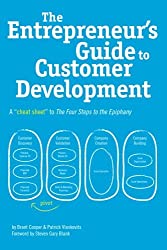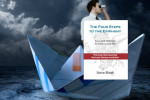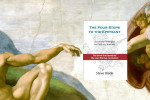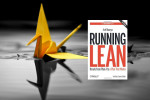Test your assumptions for effective customer discovery

The Entrepreneur’s Guide to Customer Development: A cheat sheet to The Four Steps to the Epiphany by Brant Cooper and Patrick Vlaskovits
Traditional product development processes include an intense customer requirements process at the beginning, but then separate from the customer until the marketing and sales phases begin at the completion of development. Using a waterfall approach pushes learning into later stages of development and thereby increases risk. By the time the product is complete, it is too late to perform customer discovery activities. Customer Development (#custdev on Twitter) begins with the idea that you cannot develop products without, at the same time, finding, learning about, and developing relationships with your customers. Using the Customer Development method, product development and customer development (building a path to your customer) are intertwined.
Customer Development is a four-step framework to discover and validate that you have identified the market for your product, built the right product features that solve customers’ needs, tested the correct methods for acquiring and converting customers, and deployed the right resources to scale the business.
Customer Development was created by Steve Blank and introduced in his book The Four Steps to the Epiphany. Blank’s book is an in-depth presentation of the method and contains detailed flow charts and worksheets to walk you through the process. In The Entrepreneur’s Guide to Customer Development Cooper and Vlaskovits wrote the Cliff’s Notes guide to Customer Development. The book includes key concepts of Customer Development along with the details of one of its four core processes: Customer Discovery.
Blank’s book lays out an actionable framework for starting and building new startups based on the insight that most startups fail because they didn’t develop their market, not because their didn’t develop their product.
The foundational element of Customer Development is: “question your assumptions.” At its heart, Customer Development involves taking a scientific approach to the business problem you are attempting to solve. It focuses on learning, not just iteration.
Customer Development is meant to be a complementary process to the typical linear product development process which is aimed at shipping a product. It is an iterative process which is meant to discover value through deliberate interactions with prospective customers to find product/market fit (aka “traction). It follows the “nail it, then scale it” mantra where optimization comes after validation of your value proposition.
Customer Development defines a startup as an organization specifically designed to test business models until product/market fit is achieved. A startup does this by iteratively producing minimum viable products (MVPs). Each MVP is meant to test a specific value proposition hypothesis. Large markets are most favorable because they allow plenty of space to “pivot” after each MVP is assessed. Testing your market assumptions is a key tent of Customer Development.
The four steps of Customer Development are:
- Customer Discovery – Validating that the product solves a problem for an identifiable group of customers. This is where you identify and validate your understanding of customer problems relative to your solution and MVP.
- Customer Validation – Determining that the market will purchase the product at a scale to support business viability. In this step you achieve product/market fit and find your business model.
- Company Creation – Developing a scalable business through repeatable sales and marketing activities. Now that you’ve achieved “traction”, you can start to scale (and get funding).
- Company Building – Creating resources and functional groups to support business scale.
The authors offer several tests for “product/market fit”:
- In a traditional business model in which the product is sold for money, the customer is willing to pay for the product
- Customer acquisition cost is less than lifetime value of that customer
- The size of the market supports the business
Additionally, Sean Ellis says that “achieving Product-Market fit requires at least 40% of your customers saying they would be “very disappointed” without your product. This concept is fleshed out more fully in Ash Maurya’s e-book Running Lean.
In this interview with Vlaskovits he describes his epiphany having read Steve Blank’s book: “…all the stuff I’d read before described a sort of ‘rah-rah’ process (don’t give up; persevere) but hadn’t described the meta-patters that you in see in startups across the board.”
This video features Brant Cooper talking how his experience in startups led him to adopt the Customer Development approach: “…it’s all about questioning your assumptions and testing your business model before you try to scale it.”
More on Customer Development
Patrick Vlaskovits – @pv | vlaskovits.com
Brant Cooper – @brantcooper | market-by-numbers.com
Steven Gary Blank – @sgblank | steveblank.com







